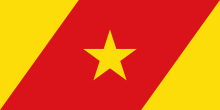Baso Liben
Baso Liben is one of the woredas in the Amhara Region of Ethiopia. A triangular-shaped district at the southernmost point of the Misraq Gojjam Zone, Baso Liben is bordered on the south by a bend of the Abay River which separates it from the Oromia Region, on the northwest by Guzamn, and on the northeast by Aneded; the Chamwaga river defines part of its western border. The major town in Baso Liben is Yejube.
Baso Liben | |
|---|---|
Woreda | |
 Flag | |
| Zone | Misraq Gojjam |
| Region | Amhara Region |
| Area | |
| • Total | 1,118.56 km2 (431.88 sq mi) |
| Population (2012 est.) | |
| • Total | 149,937 |
Rivers in this woreda include the Yada, and the Sens which is a tributary of the Chamwaga. Several fords have been used from time immemorial to cross the Abay from Baso Liben into Guduru and Cheliya woredas in the Oromia Region which are, in downriver order: the Balanti, Malka, Malka Kuki, Malka Fursi, and Malka Yekatel.[2]
Demographics
Based on the 2007 national census conducted by the Central Statistical Agency of Ethiopia (CSA), this woreda has a total population of 138,332, an increase of 22.74% over the 1994 census, of whom 68,034 are men and 70,298 women; 6,439 or 4.65% are urban inhabitants. With an area of 1,118.56 square kilometers, Baso Liben has a population density of 123.67, which is less than the Zone average of 153.8 persons per square kilometer. A total of 31,760 households were counted in this woreda, resulting in an average of 4.36 persons to a household, and 31,200 housing units. The majority of the inhabitants practiced Ethiopian Orthodox Christianity, with 99.09% reporting that as their religion.[3]
The 1994 national census reported a total population for this woreda of 112,707 in 24,320 households, of whom 56,339 were men and 56,368 were women; 3,747 or 3.32% of its population were urban dwellers. The largest ethnic group reported in Baso Liben was the Amhara (99.91%). The majority of the inhabitants practiced Ethiopian Orthodox Christianity, with 98.59% reporting that as their religion, while 1.33% were Muslim.[4] However, Charles Beke, who travelled through this area in 1842, states that groups of Oromos had settled in this part of Gojjam, the names of their tribes becoming the names of these districts.[5]
Notes
- Geohive: Ethiopia Archived 2012-08-05 at the Wayback Machine
- Per the map in R. E. Cheesman, "The Upper Waters of the Blue Nile", Geographical Journal, 71 (1928), pp. 358-374
- Census 2007 Tables: Amhara Region Archived November 14, 2010, at the Wayback Machine, Tables 2.1, 2.4, 2.5, 3.1, 3.2 and 3.4.
- 1994 Population and Housing Census of Ethiopia: Results for Amhara Region, Vol. 1, part 1 Archived November 15, 2010, at the Wayback Machine, Tables 2.1, 2.7, 2.10, 2.17, Annex II.2 (accessed 9 April 2009)
- Charles T. Beke, "Abyssinia: Being a Continuation of Routes in That Country", Journal of the Royal Geographical Society of London, 14 (1844), p. 25